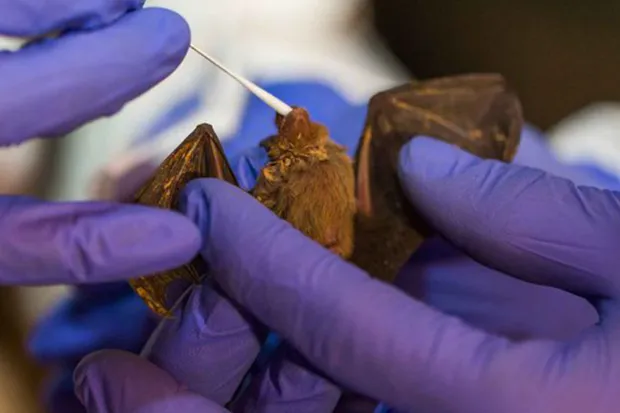Scientists Pinpoint Regions and Species Fueling Coronavirus Evolution in Bats
The outbreak of the novel coronavirus, SARS-CoV-2, which has led to the global COVID-19 pandemic, has brought to light the significance of understanding the origins and evolution of viruses. With COVID-19 tracing its roots back to a wildlife host, scientists have turned their attention to bats, which are believed to be the primary reservoir of coronaviruses. The importance of bats in the emergence of infectious diseases is not new, as they have been identified as hosts for a range of viruses, including SARS and MERS. However, the pandemic has ignited a renewed urgency to explore the role of bats in the evolution of coronaviruses, particularly in understanding the regions and species of bats that fuel these viruses’ adaptation and zoonotic transmission to humans.
Recent studies have pinpointed several critical regions and bat species as key players in the evolution of coronaviruses. These findings are crucial in devising strategies for preventing future pandemics and protecting public health. This article delves into how scientists have tracked coronavirus evolution in bats, the role of specific regions and species in this process, and what this research means for controlling emerging infectious diseases.
The Origins of SARS-CoV-2 and the Role of Bats
SARS-CoV-2 is believed to have originated in bats, with the virus likely spilling over to humans through an intermediate host. This zoonotic transfer is a common phenomenon for many viruses, including other coronaviruses such as SARS-CoV and MERS-CoV, both of which also originated in bats. However, SARS-CoV-2’s ability to spread rapidly and across the globe raised many questions about the virus’s evolutionary history.
Bats are known to harbor a variety of coronaviruses, some of which are closely related to SARS-CoV-2. They possess unique immune systems that allow them to coexist with viruses without suffering from the diseases that these viruses might cause in other mammals. As a result, bats serve as an ideal incubator for viral mutations, allowing viruses to evolve rapidly and acquire new traits that could make them more infectious to other species, including humans.
However, pinpointing the exact bat species responsible for SARS-CoV-2 or other coronaviruses has been a challenging task. Researchers have had to focus on the various regions where bats are found and study how certain bat species may contribute to the mutation and adaptation of these viruses.
The Key Regions for Coronavirus Evolution in Bats
Scientists have identified several regions of the world where bat populations are particularly rich in coronavirus diversity. These areas serve as hotspots for viral evolution, contributing to the emergence of novel viruses. The regions in question include parts of Asia, Africa, and the Middle East, which are home to a wide variety of bat species. Let’s explore these regions in detail:
1. China: The Epicenter of Coronavirus Evolution
China, particularly the southern and southwestern regions, has long been considered a hotspot for bat-related coronaviruses. Studies have shown that bats in this area harbor a diverse range of coronaviruses, some of which are closely related to SARS-CoV-2. Researchers believe that the Hubei province—where the initial outbreak of COVID-19 occurred—could have been a key location for the emergence of the virus.
Bats such as the horseshoe bats (genus Rhinolophus) are considered a primary host for SARS-CoV-2-related coronaviruses. These bats are known to carry coronaviruses that can easily mutate and adapt to new hosts. The bats in this region are often found in caves and other natural habitats that allow them to come into contact with other species, increasing the likelihood of spillover events.
2. Southeast Asia: A Region Rich in Bat Species
Southeast Asia, including countries like Thailand, Vietnam, Laos, and Malaysia, is another significant hotspot for bat-borne coronaviruses. This region is home to a diverse range of bat species, including fruit bats and insectivorous bats, which have been found to carry various strains of coronaviruses. The overlap between human populations and bat habitats in this area, particularly in rural and forested regions, increases the risk of zoonotic spillover.
The banat virus, a bat-associated coronavirus identified in the region, has been shown to share similarities with SARS-CoV-2. This discovery underscores the importance of monitoring bat populations in Southeast Asia as a means of tracking the evolution of coronaviruses and other emerging pathogens.
3. Africa: The Underexplored Frontier
While much of the research on bat-related coronaviruses has focused on Asia, Africa has been identified as an underexplored region with significant potential for viral evolution. Bats in Africa, particularly in the Central and West African regions, harbor a variety of coronaviruses that are genetically distinct from those found in Asia. Researchers have identified new bat species that carry coronaviruses, raising the possibility of untapped viral reservoirs in the continent.
In addition, the Nigerian bat has been shown to host coronaviruses similar to those found in bats from Asia. These findings highlight the need for increased surveillance in Africa to better understand the role of the continent’s bat populations in the evolution and spread of coronaviruses.
4. The Middle East: A Hotspot for Emerging Diseases
The Middle East is another critical region for understanding the evolution of coronaviruses. The Middle Eastern respiratory syndrome (MERS) virus, which was first identified in Saudi Arabia, was found to be associated with camel populations, but research also pointed to bats as potential primary hosts or intermediaries in the spread of the virus. While MERS is distinct from SARS-CoV-2, the similarities between these viruses highlight the role of the Middle East as a region of concern for future viral spillover events.
Bats in the region have been found to harbor various coronaviruses, and their interactions with other wildlife and domestic animals increase the chances of these viruses adapting to humans. As such, this region is a key area for research into coronavirus evolution and zoonotic diseases.
Bat Species Fueling Coronavirus Evolution
The next step in understanding coronavirus evolution is identifying the specific bat species that act as reservoirs for these viruses. Several species of bats have been implicated in harboring coronaviruses that are genetically similar to SARS-CoV-2. These include:
1. Horseshoe Bats (Rhinolophus)
Horseshoe bats, particularly those in the genus Rhinolophus, have been identified as key hosts for coronaviruses closely related to SARS-CoV-2. These bats are widespread in regions of Asia and Europe and are known to carry coronaviruses that are capable of mutating and adapting to new hosts. Rhinolophus species are considered the most likely source of the virus, though the exact intermediary host for SARS-CoV-2 remains uncertain.
2. Fruit Bats (Pteropus)
Fruit bats, also known as flying foxes, are another important group of bats that have been found to harbor coronaviruses. These bats are found in many regions, including Southeast Asia, Australia, and Africa. They are known to live in close proximity to human populations, which increases the likelihood of zoonotic transmission. Although fruit bats are not yet definitively linked to the spread of SARS-CoV-2, they remain a significant focus of research.
3. Insectivorous Bats
Insectivorous bats, which are more common in temperate regions, have also been found to carry coronaviruses. These bats are less likely to come into direct contact with humans but may play a role in the initial transmission of viruses to other species. These species of bats are of interest to researchers because they contribute to the overall diversity of bat-associated coronaviruses.
Implications for Public Health and Future Pandemics
Understanding the role of bats in coronavirus evolution is crucial for predicting and preventing future pandemics. The evolution of coronaviruses in bats is a dynamic process, and identifying the regions and species that contribute to this evolution can help public health authorities prepare for potential outbreaks. Monitoring bat populations, studying the viruses they carry, and tracking changes in the virus’s genetic makeup are essential steps in reducing the risk of future zoonotic spillovers.
Efforts to limit human-bat interactions in high-risk regions, improve wildlife surveillance, and implement early-warning systems could help prevent the next pandemic. Additionally, understanding the factors that drive viral evolution in bats, such as environmental changes, habitat loss, and human encroachment, will be essential in mitigating the risk of future outbreaks.
The discovery of regions and species fueling coronavirus evolution in bats provides critical insights into the origins of SARS-CoV-2 and other emerging diseases. By pinpointing specific bat populations and their habitats, scientists are uncovering the complex dynamics that drive the evolution of coronaviruses. This research is vital not only for understanding how viruses evolve but also for developing strategies to prevent future pandemics. As we continue to investigate the role of bats in virus evolution, it is clear that collaboration between scientists, public health experts, and governments will be essential in safeguarding against the next global health crisis.























